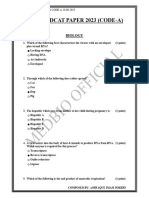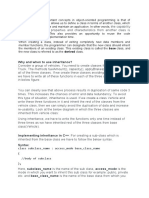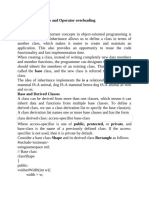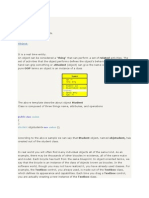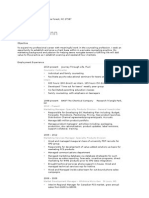Module 4 Part 1 Inheritance
Uploaded by
annaleighvaldez2Module 4 Part 1 Inheritance
Uploaded by
annaleighvaldez2MANUEL V GALLEGO FOUNDATION COLLEGES, INC.
INSTITUTE OF INFORMATION AND COMPUTER TECHNOLOGY
Computer Programming 1 ICT113
MODULE IV:
INTENDED LEARNING OUTCOMES:
Learners at the end of the module will be able to:
1. Explain the different concepts surrounding the object-oriented programming paradigm, and how they
help in creating efficient C++ programs
2. Create C++ programs with Inheritance and Polymorphism concepts.
COURSE CONTENT:
C++ Inheritance
One of the most important concepts in object-oriented programming is that of inheritance. Inheritance
allows us to define a class in terms of another class, which makes it easier to create and maintain an
application. This also provides an opportunity to reuse the code functionality and fast implementation
time.
When creating a class, instead of writing completely new data members and member functions, the
programmer can designate that the new class should inherit the members of an existing class. This
existing class is called the base class, and the new class is referred to as the derived class.
The idea of inheritance implements the is a relationship. For example, mammal IS-A animal, dog IS-A
mammal hence dog IS-A animal as well and so on.
Base and Derived Classes
A class can be derived from more than one classes, which means it can inherit data and functions from
multiple base classes. To define a derived class, we use a class derivation list to specify the base
class(es).
Where access-specifier is one of public, protected, or private, and base-class is the name of a
previously defined class. If the access-specifier is not used, then it is private by default.
Consider a base class Shape and its derived class Rectangle as follows –
#include <iostream>
using namespace std;
// Base class
class Shape {
public:
int width;
int height;
void setWidth(int w) {
width = w;
}
void setHeight(int h) {
height = h;
}
};
// Derived class
class Rectangle: public Shape {
public:
Prepared by: Mr. John Carlo L. Azarcon Page 1 of 4
MANUEL V GALLEGO FOUNDATION COLLEGES, INC.
INSTITUTE OF INFORMATION AND COMPUTER TECHNOLOGY
Computer Programming 1 ICT113
int getArea() {
return (width * height);
}
};
int main(void) {
Rectangle Rect;
Rect.setWidth(5);
Rect.setHeight(7);
// Print the area of the object.
cout << "Total area: " << Rect.getArea() << endl;
return 0;
}
When the above code is compiled and executed, it produces the following result –
Total area: 35
Access Control and Inheritance
A derived class can access all the non-private members of its base class. Thus base-class members
that should not be accessible to the member functions of derived classes should be declared private in
the base class.
We can summarize the different access types according to - who can access them in the following way
−
Access public protected private
Same class yes yes yes
Derived classes yes yes no
Outside classes yes no no
A derived class inherits all base class methods with the following exceptions −
• Constructors, destructors and copy constructors of the base class.
• Overloaded operators of the base class.
• The friend functions of the base class.
Classifications of Inheritance
When deriving a class from a base class, the base class may be inherited through public, protected or
private inheritance. The type of inheritance is specified by the access-specifier as explained above.
We hardly use protected or private inheritance, but public inheritance is commonly used. While using
different type of inheritance, following rules are applied −
1. Public Inheritance − When deriving a class from a public base class, public members of the
base class become public members of the derived class and protected members of the base
class become protected members of the derived class. A base class's private members are
never accessible directly from a derived class, but can be accessed through calls to the public
and protected members of the base class.
Prepared by: Mr. John Carlo L. Azarcon Page 2 of 4
MANUEL V GALLEGO FOUNDATION COLLEGES, INC.
INSTITUTE OF INFORMATION AND COMPUTER TECHNOLOGY
Computer Programming 1 ICT113
2. Protected Inheritance − When deriving from a protected base class, public and protected
members of the base class become protected members of the derived class.
3. Private Inheritance − When deriving from a private base class, public and protected
members of the base class become private members of the derived class.
Multiple Inheritance
A C++ class can inherit members from more than one class.
Where access is one of public, protected, or private and would be given for every base class and they
will be separated by comma.
#include <iostream>
using namespace std;
// Base class Shape
class Shape {
public:
void setWidth(int w) {
width = w;
}
void setHeight(int h) {
height = h;
}
protected:
int width;
int height;
};
// Base class PaintCost
class PaintCost {
public:
int getCost(int area) {
return area * 70;
}
};
// Derived class
class Rectangle: public Shape, public PaintCost {
public:
int getArea() {
return (width * height);
}
};
int main(void) {
Rectangle Rect;
int area;
Rect.setWidth(5);
Rect.setHeight(7);
area = Rect.getArea();
// Print the area of the object.
cout << "Total area: " << Rect.getArea() << endl;
// Print the total cost of painting
cout << "Total paint cost: $" << Rect.getCost(area) << endl;
Prepared by: Mr. John Carlo L. Azarcon Page 3 of 4
MANUEL V GALLEGO FOUNDATION COLLEGES, INC.
INSTITUTE OF INFORMATION AND COMPUTER TECHNOLOGY
Computer Programming 1 ICT113
return 0;
}
When the above code is compiled and executed, it produces the following result –
Total area: 35
Total paint cost: $2450
Function Overloading with OOP
You can have multiple definitions for the same function name in the same scope. The definition of the
function must differ from each other by the types and/or the number of arguments in the argument list.
You cannot overload function declarations that differ only by return type.
Following is the example where same function print() is being used to print different data types −
#include <iostream>
using namespace std;
class printData {
public:
void print(int i) {
cout << "Printing int: " << i << endl;
}
void print(double f) {
cout << "Printing float: " << f << endl;
}
void print(string c) {
cout << "Printing string: " << c << endl;
}
};
int main(void) {
printData pd;
// Call print to print integer
pd.print(5);
// Call print to print float
pd.print(500.263);
// Call print to print string
pd.print("Hello C++");
return 0;
}
When the above code is compiled and executed, it produces the following result –
Printing int: 5
Printing float: 500.263
Printing character: Hello C++
Prepared by: Mr. John Carlo L. Azarcon Page 4 of 4
You might also like
- Sindh Mdcat Paper 2023 Code-A With Official Key70% (10)Sindh Mdcat Paper 2023 Code-A With Official Key44 pages
- Analysing Political Speeches Rhetoric, Discourse and Metaphor (Jonathan Charteris-Black) (Z-Library)No ratings yetAnalysing Political Speeches Rhetoric, Discourse and Metaphor (Jonathan Charteris-Black) (Z-Library)314 pages
- Base & Derived Classes:: C++ InheritanceNo ratings yetBase & Derived Classes:: C++ Inheritance5 pages
- Why and When To Use Inheritance?: Class Subclass - Name: Access - Mode Base - Class - Name (//body of Subclass)No ratings yetWhy and When To Use Inheritance?: Class Subclass - Name: Access - Mode Base - Class - Name (//body of Subclass)8 pages
- Chapter-10 Inheritance: Inheritance Is The Capability of One Class To Inherit Properties From Another ClassNo ratings yetChapter-10 Inheritance: Inheritance Is The Capability of One Class To Inherit Properties From Another Class13 pages
- Sub Class: The Class That Inherits Properties From Another Class Is Called Sub ClassNo ratings yetSub Class: The Class That Inherits Properties From Another Class Is Called Sub Class29 pages
- Inheritance: Presented By: Er. Simarpreet Kaur Subject: Programming in C++No ratings yetInheritance: Presented By: Er. Simarpreet Kaur Subject: Programming in C++30 pages
- Object Oriented Programming With Java: Written by Amir KirshNo ratings yetObject Oriented Programming With Java: Written by Amir Kirsh42 pages
- WWW Tutorialspoint Com Cplusplus CPP Inheritance HTMNo ratings yetWWW Tutorialspoint Com Cplusplus CPP Inheritance HTM7 pages
- WWW - Cbsua.edu - PH: Central Bicol State University of AgricultureNo ratings yetWWW - Cbsua.edu - PH: Central Bicol State University of Agriculture9 pages
- Object Oriented Programming Inheritance: Fundamentals and ApplicationsFrom EverandObject Oriented Programming Inheritance: Fundamentals and ApplicationsNo ratings yet
- Java Programming Tutorial With Screen Shots & Many Code ExampleFrom EverandJava Programming Tutorial With Screen Shots & Many Code ExampleNo ratings yet
- IGNOU PGDCA MCS 206 Object Oriented Programming using Java Previous Years solved PapersFrom EverandIGNOU PGDCA MCS 206 Object Oriented Programming using Java Previous Years solved PapersNo ratings yet
- Configuring Sequences With SFC: Simatic Pcs 7No ratings yetConfiguring Sequences With SFC: Simatic Pcs 720 pages
- Determination 446 Pesticides Residue by GC Ms and LC MsNo ratings yetDetermination 446 Pesticides Residue by GC Ms and LC Ms32 pages
- 99.poultry Breeding and Multiplication Center OkNo ratings yet99.poultry Breeding and Multiplication Center Ok21 pages
- Built-In Power Supply Photoelectric SensorNo ratings yetBuilt-In Power Supply Photoelectric Sensor16 pages
- Differential geometry of manifolds Second Edition Lovett 2024 scribd downloadNo ratings yetDifferential geometry of manifolds Second Edition Lovett 2024 scribd download55 pages
- Corporate and Business Law (LW-ENG) : Syllabus and Study GuideNo ratings yetCorporate and Business Law (LW-ENG) : Syllabus and Study Guide15 pages
- CSEC - Nutrition Powerpoint Scribd VERSION100% (1)CSEC - Nutrition Powerpoint Scribd VERSION20 pages
- The Management of Productivity and Technology in Manufacturing PDF100% (2)The Management of Productivity and Technology in Manufacturing PDF333 pages
- Chapter Three Chapter Three The Multiple Linear Regression (MLR)No ratings yetChapter Three Chapter Three The Multiple Linear Regression (MLR)50 pages
- 11-09-2022 - SR - Super60 - Jee-Adv (2020-P2) - RPTA-01 - Key & Sol'sNo ratings yet11-09-2022 - SR - Super60 - Jee-Adv (2020-P2) - RPTA-01 - Key & Sol's10 pages
- ANDUALEM DEMISSIE DEGU The Effect of Working Capital Management On The Profitability of Manufacturing Companies in Ethiopia100% (1)ANDUALEM DEMISSIE DEGU The Effect of Working Capital Management On The Profitability of Manufacturing Companies in Ethiopia78 pages
- Brian Tracy 18 Pasos para Programar La Mente para El ExitoNo ratings yetBrian Tracy 18 Pasos para Programar La Mente para El Exito19 pages
- Analysing Political Speeches Rhetoric, Discourse and Metaphor (Jonathan Charteris-Black) (Z-Library)Analysing Political Speeches Rhetoric, Discourse and Metaphor (Jonathan Charteris-Black) (Z-Library)
- Why and When To Use Inheritance?: Class Subclass - Name: Access - Mode Base - Class - Name (//body of Subclass)Why and When To Use Inheritance?: Class Subclass - Name: Access - Mode Base - Class - Name (//body of Subclass)
- Chapter-10 Inheritance: Inheritance Is The Capability of One Class To Inherit Properties From Another ClassChapter-10 Inheritance: Inheritance Is The Capability of One Class To Inherit Properties From Another Class
- Sub Class: The Class That Inherits Properties From Another Class Is Called Sub ClassSub Class: The Class That Inherits Properties From Another Class Is Called Sub Class
- Inheritance: Presented By: Er. Simarpreet Kaur Subject: Programming in C++Inheritance: Presented By: Er. Simarpreet Kaur Subject: Programming in C++
- Object Oriented Programming With Java: Written by Amir KirshObject Oriented Programming With Java: Written by Amir Kirsh
- WWW Tutorialspoint Com Cplusplus CPP Inheritance HTMWWW Tutorialspoint Com Cplusplus CPP Inheritance HTM
- WWW - Cbsua.edu - PH: Central Bicol State University of AgricultureWWW - Cbsua.edu - PH: Central Bicol State University of Agriculture
- Object Oriented Programming Inheritance: Fundamentals and ApplicationsFrom EverandObject Oriented Programming Inheritance: Fundamentals and Applications
- Java Programming Tutorial With Screen Shots & Many Code ExampleFrom EverandJava Programming Tutorial With Screen Shots & Many Code Example
- IGNOU PGDCA MCS 206 Object Oriented Programming using Java Previous Years solved PapersFrom EverandIGNOU PGDCA MCS 206 Object Oriented Programming using Java Previous Years solved Papers
- Determination 446 Pesticides Residue by GC Ms and LC MsDetermination 446 Pesticides Residue by GC Ms and LC Ms
- Differential geometry of manifolds Second Edition Lovett 2024 scribd downloadDifferential geometry of manifolds Second Edition Lovett 2024 scribd download
- Corporate and Business Law (LW-ENG) : Syllabus and Study GuideCorporate and Business Law (LW-ENG) : Syllabus and Study Guide
- The Management of Productivity and Technology in Manufacturing PDFThe Management of Productivity and Technology in Manufacturing PDF
- Chapter Three Chapter Three The Multiple Linear Regression (MLR)Chapter Three Chapter Three The Multiple Linear Regression (MLR)
- 11-09-2022 - SR - Super60 - Jee-Adv (2020-P2) - RPTA-01 - Key & Sol's11-09-2022 - SR - Super60 - Jee-Adv (2020-P2) - RPTA-01 - Key & Sol's
- ANDUALEM DEMISSIE DEGU The Effect of Working Capital Management On The Profitability of Manufacturing Companies in EthiopiaANDUALEM DEMISSIE DEGU The Effect of Working Capital Management On The Profitability of Manufacturing Companies in Ethiopia
- Brian Tracy 18 Pasos para Programar La Mente para El ExitoBrian Tracy 18 Pasos para Programar La Mente para El Exito
